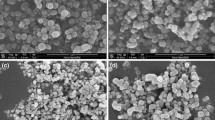Abstract
Barium titanyl oxalate (BTO) with small deviations from stoichiometry has been synthesized by a chemical and a sonochemical method (under ultrasonication). Ultrasonic processing has been shown to reduce the particle size of the resultant BTO powder by about ten times and ensure a nearly spherical shape of the particles. The morphology of barium titanate powders prepared by decomposing the BTO at a temperature of 900°C is similar to that of the parent BTO and independent of stoichiometry. The powders have a barium to titanium ratio Ba/Ti = 1.002 and 0.987. The barium titanate powders synthesized using the sonochemical method contain a smaller amount of residual phases and have a larger specific surface area, smaller crystallite size (~100 nm), and smaller unit-cell parameters than do the powders prepared without ultrasonication.
Similar content being viewed by others
References
Moulson, A.J. and Herbert, J.M., Electroceramics: Materials, Properties, Applications, New York: Wiley, 2003, p.557.
Moure, C. and Peña, O., Recent advances in perovskites: processing and properties, Prog. Solid State Chem., 2015, vol. 43, no. 4, pp. 123–148.
Pithan, C., Hennings, D., and Waser, R., Progress in the synthesis of nanocrystalline BaTiO3 powders for MLCC, Int. J. Appl. Ceram. Technol., 2005, vol. 2, no. 1, pp. 1–14.
Chatterjee, S., Stojanovic, B.D., and Maiti, H.S., Effect of additives and powder preparation techniques on PTCR properties of barium titanate, Mater. Chem. Phys., 2003, vol. 78, no. 3, pp. 702–710.
Nuraje, N. and Su, K., Perovskite ferroelectric nanomaterials, Nanoscale, 2013, no. 5, pp. 8752–8780.
Lee, S., Randall, C.A., and Liu, Z.-K., Modified phase diagram for the barium oxide–titanium dioxide system for the ferroelectric barium titanate, J. Am. Ceram. Soc., 2007, vol. 90, no. 8, pp. 2589–2594.
Cho, Y.K., Kang, S.-J.L., and Yoon, D.Y., Dependence of grain growth and grain-boundary structure on the Ba/Ti ratio in BaTiO3, J. Am. Ceram. Soc., 2004, vol. 87, no. 1, pp. 119–124.
Lee, J.K., Hong, K.-S., and Jang, J.-W., Roles of Ba/Ti ratios in the dielectric properties of BaTiO3 ceramics, J. Am. Ceram. Soc., 2001, vol. 8, no. 9, pp. 2001–2006.
Buscaglia, M.T., Buscaglia, V., Viviani, M., Nanni, P., and Hanuskova, M., Influence of foreign ions on the crystal structure of BaTiO3, J. Eur. Ceram. Soc., 2000, vol. 20, pp. 1997–2007.
Xue, L.A., Chen, Y., and Brook, RJ., The influence of ionic radii on the incorporation of trivalent dopants into BaTiO3, Mater. Sci. Eng., B, 1988, vol. 1, pp. 193–201.
Shut, V.N., Kostomarov, S.V., and Gavrilov, A.V., PTCR ceramics produced from oxalate-derived barium titanate, Inorg. Mater., 2008, vol. 44, no. 8, pp. 905–910.
Klubovich, V.V., Shut, V.N., Mozzharov, S.E., and Trublovsky, V.L., PTCR ceramics produced from ultrasound activated barium titanate powders, Inorg. Mater., 2013, vol. 49, no. 11, pp. 1162–1166.
Fang, T.-T. and Lin, H.-B., Factors affecting the preparation of barium titanyl oxalate tetrahydrate, J. Am. Ceram. Soc., 1989, vol. 72, no. 10, pp. 1899–1906.
Stockenhuber, M., Mayer, H., and Lercher, J.A., Preparation of barium titanate from oxalates, J. Am. Ceram. Soc., 1993, vol. 76, no. 5, pp. 1185–1190.
Sáez, V. and Mason, T.J., Sonoelectrochemical synthesis of nanoparticles, Molecules, 2009, vol. 14, no. 10, pp. 4284–4299.
Bang, J.H. and Suslick, K.S., Applications of ultrasound to the synthesis of nanostructured materials, Adv. Mater., 2010, vol. 22, pp. 1039–1059.
Vuttyvong, S., Niemcharoen, S., Seeharaj, P., Vittayakorn, W.C., and Vittayakorn, N., Sonochemical synthesis of spherical BaTiO3 nanoparticles, Ferroelectrics, 2013, vol. 457, no. 1, pp. 44–52.
Vakhmenina, O.N., Bokman, G.Yu., Kharash, M.Sh., Sherstobitova, L.S., and Irtegov, I.G., RF Patent 2224718, 2004.
Meskin, P.E., Ivanov, V.K., Baranchikov, A.E., Churagulov, B.R., and Tretyakov, Y.D., Ultrasonicallyassisted hydrothermal synthesis of nanocrystalline ZrO2, TiO2, NiFe2O4 and Ni0.5Zn0.5Fe2O4 powders, Ultrason. Sonochem., 2006, vol. 13, pp. 7–53.
Shut, V.N. and Kostomarov, S.V., Properties of barium titanate powders in relation to the heat treatment of the barium titanyl oxalate precursor, Inorg. Mater., 2012, vol. 48, no. 6, pp. 613–619.
Yoon, D.-H., Tetragonality of barium titanate powder for a ceramic capacitor application, J. Ceram. Process. Res., 2006, vol. 7, no. 4, pp. 343–354.
Author information
Authors and Affiliations
Corresponding author
Additional information
Original Russian Text © V.N. Shut, S.E. Mozzharov, V.V. Bobrovskii, 2018, published in Neorganicheskie Materialy, 2018, Vol. 54, No. 1, pp. 79–84.
Rights and permissions
About this article
Cite this article
Shut, V.N., Mozzharov, S.E. & Bobrovskii, V.V. Effect of Ultrasonic Processing on the Synthesis of Barium Titanyl Oxalate and the Characteristics of the BaTiO3 Powder Prepared from It. Inorg Mater 54, 72–78 (2018). https://doi.org/10.1134/S0020168518010156
Received:
Accepted:
Published:
Issue Date:
DOI: https://doi.org/10.1134/S0020168518010156




